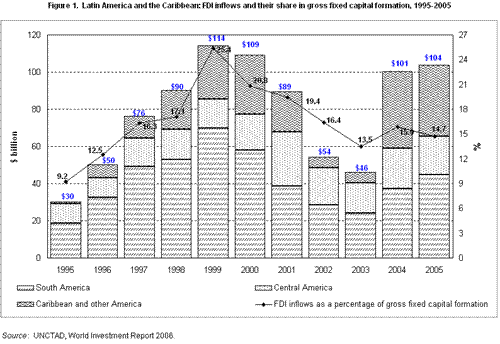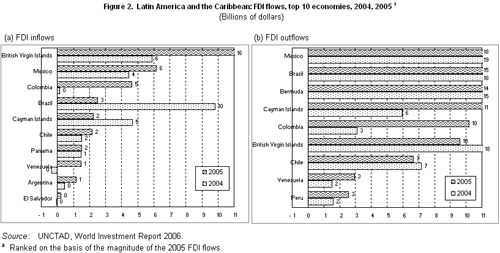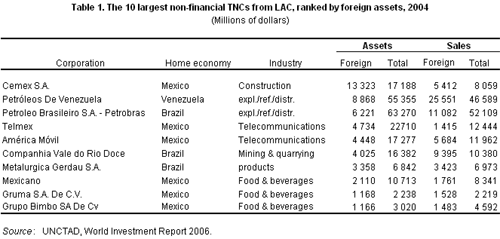| EMBARGO The contents of this press release and the related Report must not be quoted or summarized in the print, broadcast or electronic media before 16 October 2006, 17:00 GMT (1 PM New York, 19:00 Geneva, 22:30 Delhi, 02:00 - 17 October Tokyo) |
Foreign-direct-investment (FDI) inflows to Latin America and the Caribbean experienced a slight increase in 2005, according to UNCTAD´s World Investment Report 2006, FDI from Developing and Transition Economies: Implications for Development (1) , FDI climbed by 3% to US$104 billion after the strong rebound that took place in 2004, ending four years of marked decline. While the 2004 upturn was widespread, the pattern of FDI inflows in 2005 varied by sub-region. Inflows to South America rose by 20% to US$45 billion; but those to Central American and Caribbean countries, other than offshore financial centres, remained at the same level (US$23 billion); and flows to offshore financial centres decreased by 10% to US$36 billion (figure 1).
In South America the biggest increases were recorded by Andean countries such as Colombia (227%), Venezuela (95%), Ecuador (65%), Peru (61%), and Uruguay (81%). FDI to Argentina climbed slightly (9%), fell in Brazil and Chile (by -16% and -7% respectively), but remained substantial (figure 2). In Central America and the Caribbean, other than offshore financial centres, inflows decreased slightly to Mexico (-3%) and increased in other countries, apart from Cuba, Nicaragua and Honduras. In the region as a whole, Brazil and Mexico remained the main recipients of FDI, accounting for 17% and 15%, respectively, of total inflows.
Outward FDI from Latin America and the Caribbean increased by 19% to US$33 billion in 2005, of which US$14 billion originated in offshore financial centres. Excluding the latter, Mexico (US$6.2 billion), Colombia (US$4.6 billion), Brazil (US$2.5 billion) and Chile (US$2.1 billion) were the main foreign investors (figure 2). The largest transnational corporation (TNC) in terms of foreign assets in the region is Cemex (Mexico) (table 1).
The manufacturing sector has been the main regional recipient of FDI inflows (excluding offshore financial centres). Manufacturing was followed by the services sector, which continued to lose importance as compared to the primary sector. Service-related activities saw divestments by some foreign firms, continuing a trend that began in the early years of the decade. For example, EDF (France) withdrew from Argentina; Suez´s assets in that country were re-nationalized; and Telecom Italia divested assets in Peru and Chile.
In 2005, some countries registered notable changes towards a greater economic role for the State, as well as shifts in Government policies that directly concern foreign investors or industries. This was particularly the case in the natural resources sector. The most notable example is Bolivia, where the Government decreed the nationalization of hydrocarbon resources and required foreign TNCs to sign new concession contracts. Another example is Venezuela, where the Government took control of 32 oilfields previously under foreign operation. Policy reorientations were also reflected in regional agreements, with some Governments reviewing their affiliations to regional blocks. This resulted in some joining existing blocks, signing new bilateral agreements, or establishing new regional pacts. A number of policy changes in 2005 had potential positive impacts on FDI, such as promotional measures taken on behalf of carmakers in Argentina and Brazil.
FDI inflows to Latin America and the Caribbean, excluding the offshore financial centres, are expected to slow or even decline in 2006. New policy stances resulting from the situation in commodity markets and a reversal in the trend towards acquisition of local services-sector firms and assets by foreign TNCs are among the projected causes of this possible reduction.
| The World Investment Report and its database are available online at http://www.unctad.org/wir and http://www.unctad.org/fdistatistics |
ANNEX
Tables and figures
Figure 1. Latin America and the Caribbean: FDI inflows and their share in gross fixed capital formation, 1995-2005
Source: UNCTAD, World Investment Report 2006
Figure 2. Latin America and the Caribbean: FDI flows, top 10 economies, 2004, 2005a (Billions of dollars)
Source: UNCTAD, World Investment Report 2006
Note: a - Ranked on the basis of the magnitude of the 2005 FDI flows.
Table 1. The 10 largest non-financial TNCs from Latin America and the Caribbean, ranked by foreign assets, 2004 (Millions of dollars)
Source: UNCTAD, World Investment Report 2006



